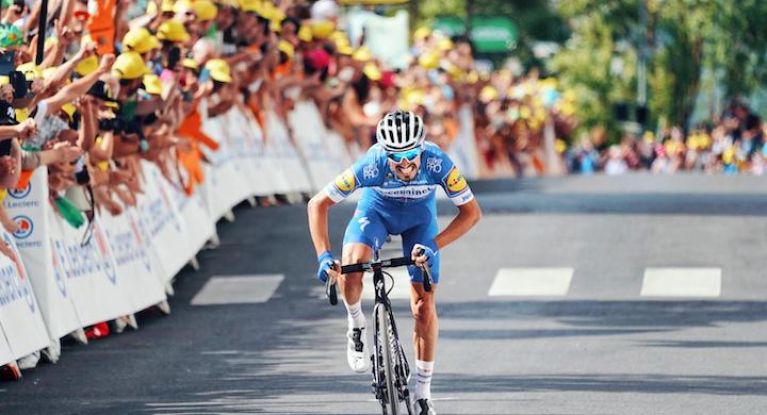
It’s that time of year again, the time when the Tour de France takes over the world of cycling and fills our TV screens with non-stop pictures of stunning, truly drop-dead gorgeous bicycles. Watching on from afar, however, it can be difficult to see the small details that go into each rider’s bike – the unique features that specialise it for a certain type of terrain.
What differentiates a sprinting bike from a climbing bike? How are they optimised for crushing a particular parcours? And who, at the current Tour de France, favours a certain piece of tech over another? Let’s find out…
In the pursuit of speed
Speed is everything to a sprinter and for that reason their bikes need to be optimised to fly as fast as possible. That means making a bike that is both the stiffest it can be, as well as the most aerodynamic – only then will it be able to win at the world’s biggest races.
Top sprinters can generate a massive amount of watts, sometimes enough to power a 700W toaster, or even snap their own components. To withstand this amount of raw power and, better yet, transform it into straight line speed, components like stems, handlebars and even the frames are manufactured from the stiffest carbon materials that money can buy.
At Specialized we construct our sprint-optimised components from the finest FACT carbon fibre, a material that’s not only incredibly sleek and lightweight but insanely stiff too. Peter Sagan is running a super-stiff combo at this year’s Tour de France: the S-Works Aerofly II carbon bars, S-Works Venge Stem and S-Works Venge carbon seatpost combining together to create a bike that is specifically designed to transfer all of his raw power into forward momentum. It clearly works, Sagan has already taken a stage win in this Tour, as well as an early and commanding lead in the points classification.
But it’s not just stiffness that gives a sprinting bike its phenomenal speed; it also comes down to the bike’s overall aerodynamics. The biggest aerodynamic improvements are made in the frame and cockpit, our S-Works Venge showing off these aero credentials better than any of our other bikes.
Smaller improvements can also be made to reduce a rider’s drag and, ultimately, increase their speed. One way is to fit a longer stem to your bike, preferably one with a negative angle. A long, negative stem stretches you out on the bike and helps you to get into a low and forward position – the most aerodynamic shape for a straight line bunch sprint.
Aero improvements can also be made in the wheels. Sprinters will often opt for deep section rims on long flat stages as they’re specifically designed to funnel air cleanly into the centre of the wheel, reducing turbulence and increasing speed. Deep section wheels also help to give you a little forward thrust by allowing air to flow over the rims at an angle, creating a small but noticeable boost in speed.
Dancing up the climbs
When it comes to climbing, whether that’s during a race as large as the Tour de France, or perhaps just during your regular weekend ride, weight is everything. With a lightweight bike at your disposal you can glide up climbs significantly faster, potentially even conquer climbs you’ve struggled on in the past.
Key characteristics of a climbing bike include a frame with narrower, rounded tubes, shallow-rimmed wheels, rim brakes and far less aerodynamic integration. All of these choices are made to shave as many grams as possible – allowing you to fly up steep climbs faster than you ever have done before.
It’s not all about lightweight frames, forks and other features however; a climbing bike also has to be incredibly stiff. Our S-Works Tarmac Ultralight is exactly that, the FACT 12r carbon fibre frame and Rider-First Engineered layup creating a bike that is remarkably stiff and able to transfer every last watt of power from your legs into forward momentum.
This is particularly important on really steep gradients when you’re laying down massive power – a stiff frame ensures that there’s no flex and no wasted energy, essential for those riders competing in long, three week events like the Tour de France.
Blurring the lines between bikes
A lot of bikes nowadays, especially here at Specialized, are beginning to overlap the sprinting and climbing categories, boasting features that make them adapted for both disciplines.
Our super-versatile S-Works Tarmac is one of those bikes. While its airfoil shapes aren’t quite as pronounced as those on the Venge, they still help to significantly reduce aerodynamic drag, meaning it’s almost just as quick on flatter stages, especially if it’s equipped with a pair of deep section rims and disc brakes. In fact, this is the exact setup that Deceuninck-QuickStep rider, Julian Alaphilippe, ran on his way to Tour de France stage victory on day three of this year’s race, so it clearly works.
This bike is also incredibly lightweight so it’s perfectly suited to the mountains of this year’s Tour de France. Watch out for it under the control of riders like Alaphilippe, as well as others like Patrick Konrad, Enric Mas and Emanuel Buchmann, as they all chase a coveted mountaintop stage win in the Pyrenees and Alps over the next few weeks.
Are you a sprinter looking for a top of the range aero bike? Or a climber looking for the lightest bike possible to help you conquer the local climbs? Then come on down to one of our stores and try out a bike before you buy. Our friendly team will be more than happy to help.